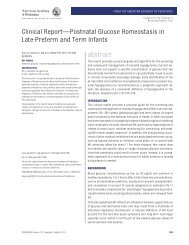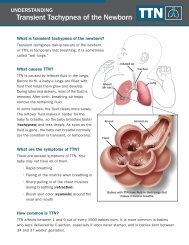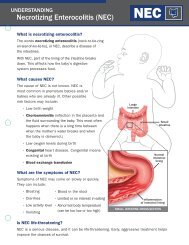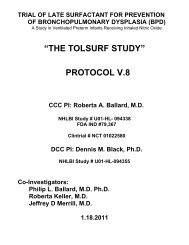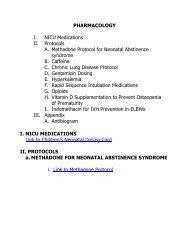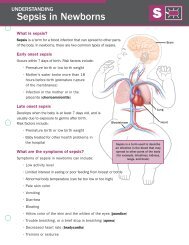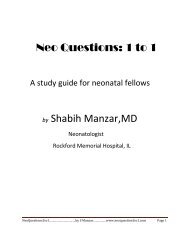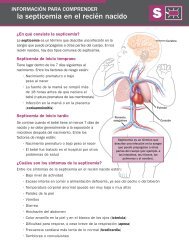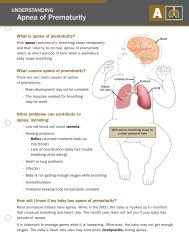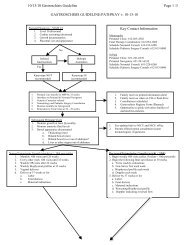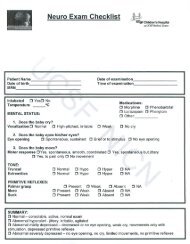Jaundice - Associates in Newborn Medicine
Jaundice - Associates in Newborn Medicine
Jaundice - Associates in Newborn Medicine
Create successful ePaper yourself
Turn your PDF publications into a flip-book with our unique Google optimized e-Paper software.
UNDERSTANDING<strong>Jaundice</strong>JWhat is jaundice?<strong>Jaundice</strong> is a word used to describe people with a yellowishcolor to their sk<strong>in</strong> and the whites of their eyes. It iscaused by build-up of a chemical called bilirub<strong>in</strong>[bill-ee-ru-b<strong>in</strong>] <strong>in</strong> the blood. Everyone has somebilirub<strong>in</strong> <strong>in</strong> their body. But when the level istoo high, known as hyperbilirub<strong>in</strong>emia, itmay cause jaundice.What causes jaundice?Before birth, the mother’s liver removesbilirub<strong>in</strong> for the baby. But after birth, thebaby’s liver must remove it. Sometimes thebody makes more bilirub<strong>in</strong> than the baby's liver canhandle. Then the bilirub<strong>in</strong> builds up <strong>in</strong> the blood andcauses jaundice.How common is jaundice?About 6 <strong>in</strong> 10 babies have jaundice. In most ofthese newborns, bilirub<strong>in</strong> levels peak a few daysto a week after birth. As the <strong>in</strong>fant feeds, thebilirub<strong>in</strong> levels usually decrease on their own.What factors affect jaundice?In some babies, the build-up of bilirub<strong>in</strong> is moreserious. This may occur if the baby:• is premature• is not eat<strong>in</strong>g well• has an <strong>in</strong>fection• has bruis<strong>in</strong>g or bleed<strong>in</strong>g <strong>in</strong>side• has a sibl<strong>in</strong>g who had jaundice• is of East Asian or Mediterranean descent• has a different blood type than their mother. This is often called an Rh/ABO <strong>in</strong>compatibility• is breastfeed<strong>in</strong>gThese babies are more likely to need treatment for jaundice.LiverStomachThe body makes bilirub<strong>in</strong> when it breaks downold red blood cells. The liver gets rid of bilirub<strong>in</strong>.Sometimes the body makes more bilirub<strong>in</strong> thanthe liver can handle. Then the bilirub<strong>in</strong> buildsup <strong>in</strong> the blood and causes jaundice.
Treat<strong>in</strong>g <strong>Jaundice</strong>Does jaundice cause permanent problems?In most cases, jaundice is short-term and causes no last<strong>in</strong>gproblems. In very severe and/or untreated cases, permanenthealth problems can occur. This happens more often <strong>in</strong> <strong>in</strong>fantswho are very premature or very sick. Early treatment can helpprevent these problems.What treatment will my baby receive?• Mild cases of jaundice do not require any treatment. Thebilirub<strong>in</strong> build-up often goes away with<strong>in</strong> a week after birth.• Moderate cases of jaundice are most often treated withspecial lights. This treatment is called phototherapy. Ithelps the baby's body break down the extra bilirub<strong>in</strong>.– Are the lights safe? Yes, phototherapy is safe and itworks best when most of the baby's sk<strong>in</strong> is exposedto the light. The baby will wear only a diaper and asoft mask to protect the eyes. To keep warm, thebaby is often placed <strong>in</strong> a special bed or isolette.• If the jaundice is due to a blood-type difference betweenmother and baby, it may also be treated with medic<strong>in</strong>e.• Severe cases of jaundice that do not respond tophototherapy or medic<strong>in</strong>e are rare. In these cases, doctorsmay perform an exchange transfusion.What will happen next?Most babies with jaundice respond well to treatment <strong>in</strong> a fewdays. But every baby is different. Some babies may require moretreatment, especially if they are not eat<strong>in</strong>g well. The health careteam will talk with you about what is best for your baby.GlossaryBilirub<strong>in</strong> – chemical that maycause jaundice when it builds up<strong>in</strong> the bodyExchange transfusion – aprocedure <strong>in</strong> which doctorsrepeatedly remove small amountsof blood from the baby andreplace it with equal amountsof donor bloodHyperbilirub<strong>in</strong>emia – buildup ofa chemical called bilirub<strong>in</strong> <strong>in</strong> thebody (may cause jaundice)<strong>Jaundice</strong> – yellow color of the sk<strong>in</strong>and whites of the eyesPhototherapy – us<strong>in</strong>g speciallights to help the baby get ridof the bilirub<strong>in</strong> build-up that iscaus<strong>in</strong>g jaundiceRh/ABO <strong>in</strong>compatibility –difference <strong>in</strong> blood type betweenthe mother and the baby. Thiscan <strong>in</strong>crease the risk or severityof jaundiceAsk the health care team whenyou have questions—they arethere to help.NOTES:________________________________________________________________________________________________________________________________________________________________________________________________________________________________________________________________________________________________________________________________________________________________________________________________________________________________________________________________________________________________________________________________________________________________________________Signature: __________________________________________ Date:__________________ Time: ____________© 2011 Ikaria, Inc. IMK111-01341A September 2011



